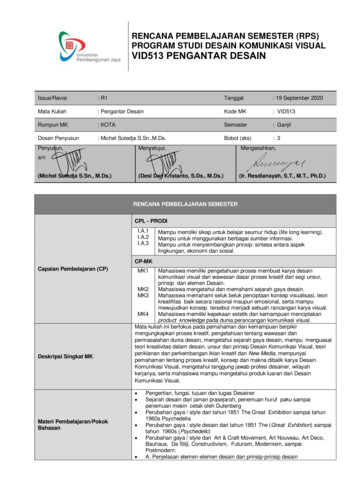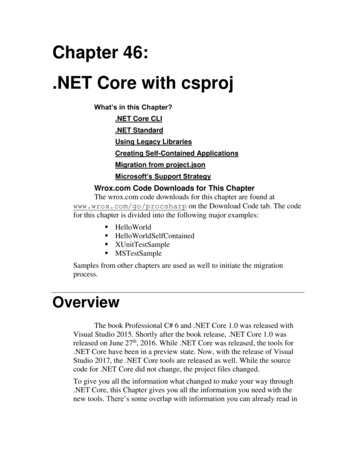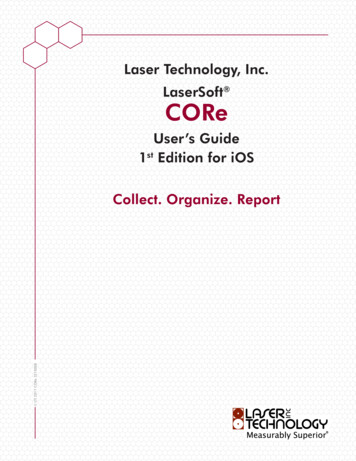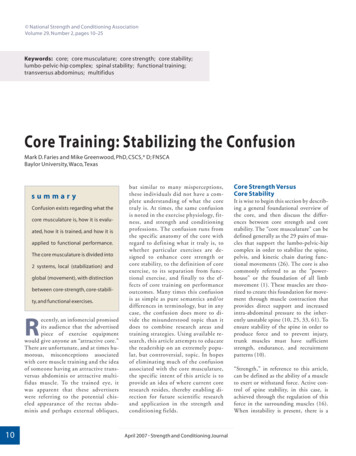
Transcription
B.COM (H) – Core 12 - Semester VFUNDAMENTALS OFFINANCIAL MANAGEMENTAuthor:Dr.Biswo Ranjan MishraEdited By:Dr.Sujit Kumar AcharyaDr.Rashmi Ranjeeta DasUTKAL UNIVERSITYDirectorate of Distance & Continuing EducationBhubaneswar
SYLLABUS(Core-12)FUNDAMENTALS OF FINANCIAL MANAGEMENTObjective: To familiarize the students with the principles and practices of financialmanagement.Contents:Unit – I: Introduction& Basic ConceptsImportant functions of Financial Management, Objectives of the firm: Profit maximizationvs. Value maximization, Role of Chief Financial Officer. Financial environment in whicha firm has to operate, Time Value of Money: concept and reasons, Compounding andDiscounting techniques, Concepts of Annuity and Perpetuity. Risk-return relationship(Concepts only)Unit – II: Sources of Finance and Cost of Capital/ Financing DecisionsDifferent sources of finance; long term and short term sources, Cost of capital: concept,relevance of cost of capital, Implicit and Explicit cost, specific costs (its computation)and weighted average cost (its computation) , rationale of after tax weighted averagecost of capital, marginal cost of capital (its computation).Unit – III: Capital Expenditure Decisions / Long term Financial Decisions &Dividend DecisionsCapital Expenditure Decisions / Long term Financial DecisionsObjectives of Capital Budgeting Process, Concept of Cash flow, Methods of long termInvestment decisions - Discounted Payback Period, Net Present Value, ProfitabilityIndex, Average Rate of Return / Accounting Rate of Return, Internal Rate of Return(Including relative merits and demerits of each of the methods)Dividend DecisionsMeaning, Nature and Types of Dividend, concept of pay-out ratio, retention ratioDecisions and growth, Dividend policies and formulating a dividend policy, DividendTheories: Walter’s Model, Gordon’s ModelUnit – IV: Working Capital Management/ Liquidity ManagementMeaning and various concepts of Working Capital, Management of Working Capital andIssues in Working Capital, Estimating Working Capital Needs; Operating or WorkingCapital Cycle, Policies relating to Current Assets – Conservative, Aggressive andBalance, Various sources of finance to meet working capital requirementsLearning Outcome:
After the completion of this paper, students will be able to understand finance in a betterway along with giving them insight to practical management of long and short financefor real business houses.Text Books Recommended1. Rostogi, Fundamentals of Financial Management, Taxmann Publications2. Fundamental of Financial Management, Sharma, Gupta, Kalyani Publishers, NewDelhi.Suggested Readings1. Fundamentals of Financial Management, Vandana Dangi, V.K. Global Pvt. Ltd., NewDelhi2. Parasuraman – Financial Management: A Step by Step Approach, Cengage Learning3. Pandey, I.M. Financial Management. Vikas Publications.4. Financial Management, Himalaya Publishing House5. BhallaV.K – Financial Management – S.Chand6. Horne, J.C. Van and Wackowich. Fundamentals of Financial Management. 9 tged.New Delhi Prentice Hall of India.
UNIT-1INTRODUCTION OF FINANCIAL MANAGEMENTSTRUCTURE:1.0 Introduction1.1 Learning Objectives1.2 Meaning, Nature and Scope of Finance1.2.1.Nature of Financial Management1.2.2 Real and Financial Assets1.2.3 Equity and Borrowed Funds1.2.4 Finance and Management Functions1.2.5 Scope of Financial Management/Finance Function1.3 Financial Goal: Profit Maximization vs Wealth Maximization1.3.1 Profit Maximization1.3.2 Objections to Profit Maximization1.3.3 Maximizing Profit after Taxes1.3.4 Maximizing EPS13.5 Shareholders' Wealth Maximization1.3.6 Profit Maximization vs Wealth Maximization1.3.7 Need for a Valuation Approach1.3.8 Risk-Return Trade-Off1.4 Finance Functions1.4.1 Investment Decision1.4.2 Financing Decision1.4.3 Dividend Decision1.4.4 Liquidity Decision1.5 Innovative Finance Functions1.5.1 Fund Raising1.5.2 Fund Allocation1.5.3 Profit Planning1.5.4 Understanding Capital Markets1.5.5 Status and Duties of Finance Executives1.5.6 Controller's and Treasurer's Functions in the Indian Context1.6 Summary1.7 Key Terms1.8 Answers to 'Check Your Progress'1.9 Questions and Exercises1.10 Further Reading
1.0 INTRODUCTIONFinancial management is concerned with the planning and controlling of a firm'sfinancial resources. It was a branch of economics till 1890 and recently it has become aseparate discipline. The subject of financial management is of immense interest to bothacademicians and practicing managers. It is of interest to academicians because thesubject is still developing, and there are areas where controversies still exist for whichno unanimous solutions have been found. Practicing managers are interested in thissubject because the most crucial decisions of the firm are related to finance, and anunderstanding of the theory of financial management enables them to make thosedecisions skillfully and correctly. This unit will discuss the nature and scope of finance,the financial goals of organizations and finance functions.1.1 LEARNING OBJECTIVESAfter going through this unit, you will be able to: 1.2Explain the nature of finance and its interaction with other managementfunctions.Review the changing role of a finance manager and his/her position in themanagement hierarchy.Discuss agency problems arising from the relationship between shareholdersand managers.Illustrate the organization of the finance function.Focus on shareholder’s wealth maximization principle.MEANING, NATURE AND SCOPE OF FINANCEWhat is finance? What are the firm's financial activities? How are they related to thefirm's other activities? Financial management is a long term decision making processwhich involves lot of planning, allocation of funds, discipline and much more. Nobodycan ever think to start a business or a company without financial knowledge andmanagement strategies. Finance links itself directly to several functional departmentslike marketing, production and personnel. .Let us understand the nature offinancial management with reference of this discipline.1.2.1Nature of Financial Management: Finance management is a long termdecision making process which involves lot of planning, allocation of funds, disciplineand much more. Let us understand the nature of financial management with referenceof this discipline.1. Financial management is one of the important educations which have been realizedword wide. Now a day’s people are undergoing through various specialization coursesof financial management. Many people have chosen financial management as theirprofession.
2. The nature of financial management is never a separate entity. Even as anoperational manager or functional manager one has to take responsibility of financialmanagement.3. Finance is a foundation of economic activities. The person who manages finance iscalled as financial manager. Important role of financial manager is to control finance andimplement the plans. For any company financial manager plays a crucial role in it. Manytimes it happens that lack of skills or wrong decisions can lead to heavy losses to anorganization.4. Nature of financial management is multi-disciplinary. Financial management dependsupon various other factors like: accounting, banking, inflation, economy, etc. for thebetter utilization of finances.5. Approach of financial management is not limited to business functions but it is abackbone of commerce, economic and industry.Some of the major scope of financial management is as follows: 1. Investment Decision2. Financing Decision 3. Dividend Decision 4. Working Capital Decision .1.2.2 Real and Financial AssetsReal asset can be defined as “assets that are tangible or physical in nature such asproperty, plants and equipments. As an example in our bank many real assets can beidentified such as the buildings, computers, lands that we own, ATM machines,vehicles, machineries such as note counters etc.Financial assets can be defined as “assets in the form of stocks, bonds, rights,certificates, bank balances, etc., as distinguished from tangible, physical assets”(Pension Boards-UCC, 2009). For our bank financial assets can be identified as ourinvestments in bonds, issued by government and companies, bills issued bygovernment and companies, shares of other companies and debentures of othercompanies, loans we have lent, reserves we hold at Central bank and etc.Real assets are tangible and financial assets are intangible in nature. Real assets areused in day to business operations to produce/generate an output where as financialassets are used to generate a return by investing activities. In general by investing inreal assets company generates an income by way of profits earned from productionutilizing the asset, rent (from lands) and gain/loss on disposals. By investing in financialassets company earns dividends, interest income and capital gains/loss upon disposalof assets.Firms issue securities to investors in the primary capital markets to raise necessaryfunds. The securities issued by firms are traded - bought and sold - by investors in thesecondary capital markets, referred to as stock exchanges. Financial assets alsoinclude lease obligations and borrowing from banks, financial institutions and other
sources. In a lease, the lessee obtains a right to use the lessor's asset for an agreedamount of rental over the period of lease. Funds applied to assets by the firm are calledcapital expenditures or investment. The firm expects to receive return on investmentand might distribute return (or profit) as dividends to investors.1.2.3 Equity and Borrowed FundsTo raise capital, an enterprise either used owned sources or borrowed ones. Ownedcapital can be in the form of equity, whereas borrowed capital refers to the company'sowed funds or say debt. Borrowed funds refer to the borrowings of a business firm. In acompany, borrowed funds consist of the finance raised from debenture holders, publicdeposits, financial institutions and commercial banks. Equity refers to the stock,indicating the ownership interest in the company.Shareholders can be of two types: ordinary and preference. Preferenceshareholders receive dividend at a fixed rate, and they have a priority over ordinaryshareholders. The dividend rate for ordinary shareholders is not fixed, and it can varyfrom year to year depending on the decision of the board of directors. The payment ofdividends to shareholders is not a legal obligation; it depends on the discretion of theboard of directors. Since ordinary shareholders receive dividend (or repayment ofinvested capital, only when the company is wound up) after meeting the obligations ofothers, they are generally called owners of residue. Dividends paid by a company arenot deductible expenses for calculating corporate income taxes, and they are paid out ofprofits after corporate taxes. As per the current laws in India, a company is required topay 12.5 per cent tax on dividends.Equity shares, preference shares, ploughing back of profits and debentures aregenerally used for long-term finance. Public deposits, commercial banks and financialinstitutions are the main sources of medium-term and short-term finance. A companycan also obtain equity funds by retaining earnings available for shareholders.Retained earnings, which could be referred to as internal equity, are undistributedprofits of equity capital. The retention of earnings can be considered as a form of raisingnew capital. If a company distributes all earnings to shareholders, then, it can reacquirenew'' capital from the same sources (existing shareholders) by issuing new sharescalled rights shares. Also, a public issue of shares may be made to attract new (as wellas the existing) shareholders to contribute equity capital.Another important source of securing capital is creditors or lenders. Lenders arenot the owners of the company. They make money available to the firm as loan or debtand retain title to the funds lent. Loans are generally furnished for a specified period at afixed rate of interest. For lenders, the return on loans or debt comes in the form ofinterest paid by the firm. Interest is a cost of debt to the firm. Payment of interest is alegal obligation. The amount of interest paid by a firm is a deductible expense forcomputing corporate income taxes. Thus, interest provides tax shield to a firm. Theinterest tax shield is valuable to a firm. The firm may borrow funds from a large numberof sources, such as banks, financial institutions, public or by issuing bonds ordebentures. A bond or a debenture is a certificate acknowledging the amount of money
lent by a bondholder to the company. It states the amount, the rate of interest and thematurity of the bond or debenture. Since bond or debenture is a financial instrument, itcan be traded in the secondary capital markets.1.2.4 Finance and Management FunctionsThere is a valuable and undivided relationship between finance on the one hand andproduction, marketing and other functions on the other. Almost all business activities,directly or indirectly, involve the acquisition and use of funds. For example, recruitmentand promotion of employees in production is clearly a responsibility of the productiondepartment; but it requires payment of wages and salaries and other benefits, and thus,involves finance.1.2.5 Scope of Financial Management/ Finance Function:The main objective of financial management is to arrange sufficient finances formeeting short term and long term needs. A financial manager will have to concentrateon the following areas of finance function:1.Estimating Financial Requirements: The first task of financial manager is to estimate short term and long-termfinancial requirements of his business. For this purpose, he will prepare a financial planfor present as well as for future. The amount required for purchasing fixed assets aswell as for working capital will have to be ascertained.2.Deciding Capital Structure: The capital structure refers to the kind and proportion of different securitiesfor raising funds. After deciding about the quantum of funds required, it should bedecided which type of securities should be raised. It may be wise to finance fixed assetsthrough long-term debts and current assets through short-term debts.3.Selecting a Source of Finance: After preparing capital structure, an appropriate source of finance isselected. Various sources from which finance may be raised include: share capital,debentures, financial institutions, commercial banks, public deposits etc. If finance isneeded for short period then banks, public deposits and financial institutions may beappropriate. On the other hand, if long-term finance is required then, share capital, anddebentures may be useful.4.Selecting a pattern of Investment: When funds have been procured then a decision about investment patternis to be taken. The selection of an investment pattern is related to the use of funds. Adecision will have to be taken as to which asset is to be purchased. The funds will haveto be spent first on fixed assets and then an appropriate portion will be retained forworking capital. The decision-making techniques such as capital budgeting, opportunitycost analysis etc. may be applied in making decisions about capital expenditures.5.Proper cash Management: Cash management is an important task of finance manager. He has toassess various cash needs at different times and then make arrangements for arrangingcash. The cash management should be such that neither there is a shortage of it andnor it is idle. Any shortage of cash will damage the credit worthiness of the enterprise.
The idle cash with the business will mean that it is not properly used. Cash flowstatements are used to find out various sources and application of cash.6.Implementing Financial Controls:An efficient system of financial management necessitates the use ofvarious control devises. Financial control devises generally used are budgetary control,break even analysis; cost control, ratio analysis etc. The use of various techniques bythe finance manager will help him in evaluating the performance in various areas andtake corrective measures whenever needed.7.Proper use of Surplus: The utilization of profit or surplus is also an important factor in financialmanagement. A judicious use of surpluses is essential for expansion and diversificationplan and also in protecting the interest of shareholders. The finance manager shouldconsider the following factors before declaring the dividend;a.Trend of earnings of the enterpriseb.Expected earnings in future.c.Market value of shares.d.Shareholders interest.e.Needs of fund for expansion etc.1.3 FINANCIAL GOAL: PROFIT MAXIMIZATION VS WEALTH MAXIMIZATIONThe objective of a Financial Management is to design a method of operating the InternalInvestment and financing of a firm. The two widely used approaches are ProfitMaximization and Wealth maximization.Investment and financing decisions of the firm's are continuous and unavoidable.Generally the financial goal of the firm should be shareholders' wealth maximization(SWM), as reflected in the market value of the firm's shares. In this section, we showthat the shareholders' wealth maximization is theoretically logical and operationallyfeasible for guiding the financial decision-making.1.3.1 Profit MaximizationProfit maximization is considered as the goal of financial management. In thisapproach actions that increase the profits should be undertaken and the actions thatdecrease the profits are avoided. The term 'profit' is used in two senses. In one sense itis used as an owner oriented. In this concept it refers to the amount and share ofnational Income that is paid to the owners of business. The second way is anoperational concept i.e. profitability. It is the traditional and narrow approach, whichaims at, maximizes the profit of the concern. The Ultimate aim of the business concernis earning profit, hence, it considers all the possible ways to increase the profitability ofthe concern. Profit is the parameter of measuring the efficiency of the business concern.So it shows the entire position of the business concern. And hence Profit maximizationobjectives help to reduce the risk of the business. Its main aim is to earn profit. In thiscriteria Profit is the main parameter of business operation. It reduces the risk of
business concern. In this criteria profit is the main source of finance and profitabilitymeets the social needs.Some of the unfavorable arguments of profit maximizations are that it leadsto exploiting workers and consumers. It also creates immoral practices such as corruptpractice, unfair trade practice, etc. It also creates inequalities among the stake holderssuch as customers, suppliers, public shareholders, etc.1.3.2 Objections to Profit Maximization1. In Profit Maximization, profit is not defined precisely or correctly. It creates someunnecessary opinion regarding earning habits of the business concern. Forexample, profit may be long term or short term. It may be total profit or rate ofprofit. It may be net profit before tax or net profit after tax. It may be return ontotal capital employed or total assets or shareholders equity and so on.2. It ignores the time value of money: Profit maximization does not consider thetime value of money or the net present value of the cash inflow. It leads certaindifferences between the actual cash inflow and net present cash flow during aparticular period. When the profitability is worked out the bigger the betterprinciple is adopted as the decision is based on the total benefits received overthe working life of the asset, Irrespective of when they were received.3. It ignores the quality aspects of benefits which are associated with the financialcourse of action. The term 'quality' means the degree of certainty associated withwhich benefits can be expected. Therefore, the more certain the expected return,the higher the quality of benefits. As against this, the more uncertain orfluctuating the expected benefits, the lower the quality of benefits.4. It ignores risk: Profit maximization does not consider risk of the businessconcern. Risks may be internal or external which will affect the overall operationof the business concern.It suffers from the following limitations: It is vague It ignores the timing of returns It ignores risk.Definition of profit: “Profit” is a vague term. It is because different mindset will have adifferent perception of profit. For e.g. profits can be the net profit, gross profit, before taxprofit, or the rate of profit, short- or long-term profit, total profits or profit per share. Doesit mean total operating profit or profit accruing to shareholders ,etc.?Time value of MoneyThe profit maximization formula simply suggests “higher the profit better is theproposal”. In essence, it is considering the naked profits without considering the timingof them. Another important dictum of finance says “a dollar today is not equal to a dollara year later”. So, the time value of money is completely ignored.
Uncertainty of returns: A decision solely based on profit maximization model wouldtake a decision in favor of profits. In the pursuit of profits, the risk involved is ignoredwhich may prove unaffordable at times simply because higher risks directly questionsthe survival of a business. The streams of benefits may possess different degree ofcertainty. Two firms may have same total expected earnings, but if the earnings of onefirm fluctuate considerably as compared to the other, it will be more risky. Possibly,owners of the firm would prefer smaller but surer profits to potentially larger but lesscertain profits.Ignores QualityThe most problematic aspect of profit maximization as an objective is that it ignores theintangible benefits such as quality, image, technological advancements etc. Thecontribution of intangible assets in generating value for a business is not worth ignoring.They indirectly create assets for the organization .1.3.3 Maximizing Profit after TaxesProfit after tax is the net profit attributable to shareholders of a companyafter all costs and taxes have been deducted. This is the amount left to be paid out asdividends to shareholders as a return on their investment or to be ploughedback into thebusiness as undistributed profits to add to the company's reserve.Maximisingprofitmeans maximising profits after taxes, in the sense of net profit as reported in the profitand loss account (income statement) of the firm. It can easily be realised thatmaximising this figure will not maximize the economic welfare of the owners. It ispossible for a firm to increase profit after taxes by selling additional equity shares andinvesting the proceeds in low-yielding assets, such as the government bonds. Profitafter taxes would increase but earnings per share (EPS) would decrease. To illustrate,let us assume that a company has 20,000 shares outstanding, profit after taxes ofRs.1,00,000 and earnings per share of Rs.5. If the company sells 20,000 additionalshares at Rs.50 per share and invests the proceeds (10,00,000) at 5 per cent aftertaxes, then the total profits after taxes will increase to Rs.150,000. However, theearnings per share will fall to Rs.3.75 (i.e.,Rs.150,000/40,000). This example clearlyindicates that maximising profits after taxes does not necessarily serve the bestinterests of owners.1.3.4 Maximizing EPSEarnings per share (EPS) is the portion of the company’s distributable profit which isallocated to each outstanding equity share (common share). Earnings per share are avery good indicator of the profitability of any organization, and it is one of the mostwidely used measures of profitability.The earnings per share are a useful measure of profitability, and when compared withEPS of other similar companies, it gives a view of the comparative earning power of thecompanies. EPS when calculated over a number of years indicates whether the earning
power of the company has improved or deteriorated. Investors usually look forcompanies with steadily increasing earnings per share.Growth in EPS is an important measure of management performance because it showshow much money the company is making for its shareholders, not only due to changesin profit, but also after all the effects of issuance of new shares (this is especiallyimportant when the growth comes as a result of acquisition).If we adopt maximising EPS as the financial objective of the firm, this will also notensure the maximization of owners' economic welfare. It also suffers from the flawsalready mentioned, i.e. it ignores timing and risk of the expected benefits.It is, thus, clear that maximising profits after taxes or EPS as the financialobjective fails to maximize the economic welfare of owners. Both methods do not takeaccount of the timing and uncertainty of the benefits. An alternative to profitmaximization, which solves these problems, is the objective of wealth maximization.1.3.5 Wealth Maximization: Wealth maximization is one of the modern approaches,which involves latest innovations and improvements in the field of the business concern.The term wealth means shareholder wealth or the wealth of the persons those who areinvolved in the business concern. Wealth maximization is also known as valuemaximization or net present worth maximization. This objective is a universally acceptedconcept in the field of business. It removes technical disadvantages of the profitmaximization. Wealth maximization is superior to the profit maximization because themain aim of the business concern under this concept is to improve the value or wealthof the shareholders. Wealth maximization considers the comparison of the value to costassociated with the business concern. Total value detected from the total cost incurredfor the business operation. It provides extract value of the business concern. Thisconcept considers both time and risk of business concern. This criterion providesefficient allocation of resources and it also ensures the economic interest of the society.The wealth maximization criterion is based on cash flows generated and not onaccounting profit. The computation of cash inflows and cash outflows is precise. Wealthmaximization can be activated only with the help of the profitable position of thebusiness concern. So the goal of maximizing the value of the stock avoids the problemsassociated with the different goals we discussed above. In a simple language a goodfinancial decisions increase the market value of the owners’ equity and poor financialdecisions decrease it. So the financial manager best serves the owners of the businessby identifying goods and services that add value to the firm because they are desiredand valued in the free marketplace. So it is a long term concept based on the cash flowsrather than profits and hence there can be a situation where a business makes lossesevery year but there are cash profits because of heavy depreciation which indirectlysuggests heavy investment in fixed assets and that is the real wealth and it takes intoaccount the time value of money and so is universally accepted .ShareShare Profit Maximisation an d Wealth Maximisation
1.3.6 Profit maximization vs. wealth maximizationThe essential difference between the maximization of profits and the maximizationof wealth is that the profits focus is on short-term earnings, while the wealth focus ison increasing the overall value of the business entity over time. These differencesare substantial, as noted below: Planning duration. Under profit maximization, the immediate increase of profits isparamount, so management may elect not to pay for discretionary expenses, suchas advertising, research, and maintenance. Under wealth maximization,management always pays for the discretionary expenditures.Risk management. Under profit maximization, management minimizes expenditures,so it is less likely to pay for hedges that could reduce the organization's risk profile.A wealth-focused company would work on risk mitigation, so its risk of loss isreduced.Pricing strategy. When management wants to maximize profits, it prices products ashigh as possible in order to increase margins. A wealth-oriented company could dothe reverse, electing to reduce prices in order to build market share over the longterm.Capacity planning. A profit-oriented business will spend just enough on itsproductive capacity to handle the existing sales level and perhaps the short-termsales forecast. A wealth-oriented business will spend more heavily on capacity inorder to meet its long-term sales projections.It should be apparent from the preceding discussion that profit maximization is astrictly short-term approach to managing a business, which could be damaging overthe long term. Wealth maximization focuses attention on the long term, requiring alarger investment and lower short-term profits, but with a long-term payoff thatincreases the value of the business.1.3.7 Need for a Valuation ApproachThe necessity for valuation of shares arises in the following circumstances: Assessments under the wealth tax or gift tax acts.Purchase of a block of shares which may or may not give the holder thereof acontrolling interest in the company.Purchase of share by the employees of the company where the retention of suchshares is limited to the period of their employment.Formulation of schemes of amalgamation, absorption, etc.Acquisition of interest of dissenting shareholders under a scheme ofrationalization.Compensating shareholders on the acquisition of their shares by the governmentunder a scheme of rationalization.Conversation of shares i.e. preference into equity.
Advancing of loan on the security of shares.Resolving a deadlock in the management of a private limited company on thebasis of the controlling block of shares being given to either of the parties.Normally, the price prevailing on the stoc
Fundamental of Financial Management, Sharma, Gupta, Kalyani Publishers, New Delhi. Suggested Readings 1. Fundamentals of Financial Management, Vandana Dangi, V.K. Global Pvt. Ltd., . Financial management is a long term decision making process which involves lot of planni











